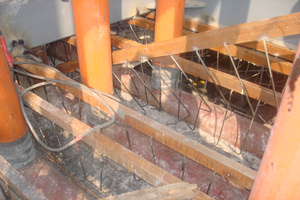The use of rotary kilns to treat hazardous waste has many advantages, but there are also some problems in actual engineering, such as coking problems, safety problems, etc., which need to be further solved and the system optimized.
1) Coking problem
There are two main types of coking in the process of treating hazardous waste in the rotary kiln: coking of low melting point salts in the furnace; cold air infiltration in the gap of the sealing sheet at the slag outlet at the kiln tail and evaporation of moisture in the slag remover, causing local The temperature drops to form coke.
The principle of the formation of the first coking method is: in the process of incinerating waste, hazardous waste will be decomposed at high temperature, and the decomposed elements will be recombined at high temperature to form a part of low melting point salts (mainly alkaline components). and halide). These low melting point salts are very viscous at high temperatures, they will stick to themselves and adhere to other substances and coke in the rotary kiln.
This kind of coke is not easy to remove. The main method is to control the feed of waste and control the combustion temperature of the incinerator. Usually, the following measures are used to prevent coke:
(1) when feeding, the wastes containing sodium, potassium and other components and the wastes with high halogen content are arranged to be incinerated in different time periods;
(2) For wastes with high salt content, mix with other wastes, such as mixing substances with high melting point such as lime, etc., and then incinerate;
(3) Control the incineration temperature and supply air reasonably;
(4) Choose refractory bricks that can prevent wall hanging.
If there is serious coking of low melting point salt in the kiln, the combustion temperature of the rotary kiln can be appropriately lowered, and the temperature in the kiln can be adjusted to the normal operating temperature after the low melting point salt is incinerated smoothly and enters the slag discharge system.
The second coking method is mainly caused by the ash and slag being cooled and solidified. The removal method is to use the decoking combustion nozzle installed on the rear end plate of the rotary kiln to melt and make it fall off. In order to prevent coking in this way, an efficient sealing device can be used to prevent the intrusion of cold air.
2) Security issues
The biggest safety problem in the use of rotary kiln for hazardous waste treatment system is that the pressure in the rotary kiln increases rapidly in a short period of time, exceeding the limit value, causing equipment damage, leakage of harmful flue gas and other substances, and even explosion.
There are two main reasons for the rapid increase in the pressure in the rotary kiln: the deflagration of the hazardous waste in the rotary kiln; the sudden power failure of the system, which causes the induced draft fan in the subsequent flue gas treatment system to stop working.
In order to ensure the safety of the rotary kiln incineration system, in addition to the use of the interlocking control safety system, there are two sets of safety protection measures in the mechanical design: the first-level pressure relief of the water seal tank of the slag remover. The water seal tank of the slag remover acts as a seal during normal operation to isolate the kiln flue gas from the outside atmosphere. When the pressure in the kiln is higher than the safety set value, the flue gas will break through the water seal and automatically release to ensure the safety of the incineration system.
Secondary relief of emergency exhaust stack. A section of emergency exhaust chimney is designed at the top of the secondary combustion chamber. The chimney leads to the outdoors, and the system is in a closed state during normal operation, but when the pressure in the incineration system reaches the limit value, the internal high-pressure flue gas can flush the door cover on the chimney and be discharged to the atmosphere to protect the safety of the system.



